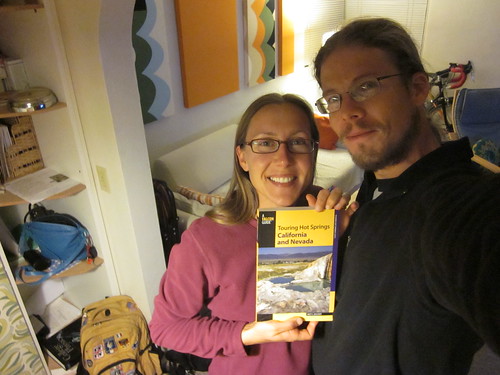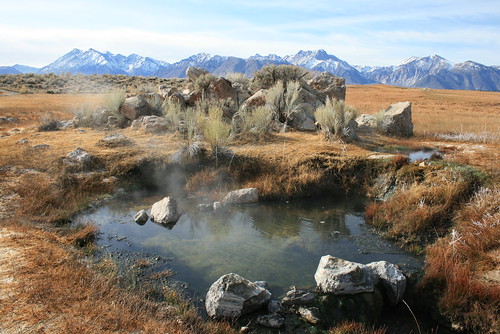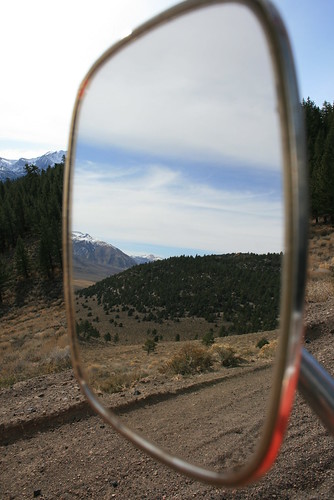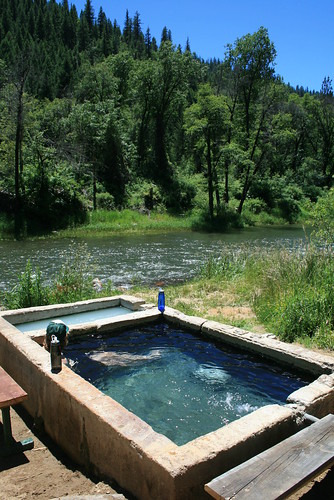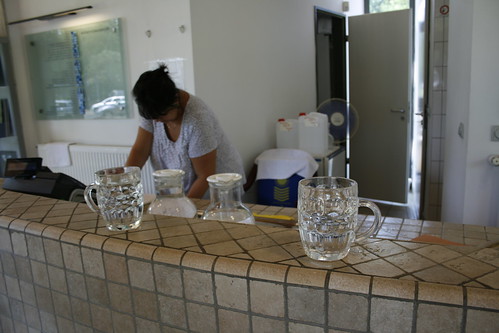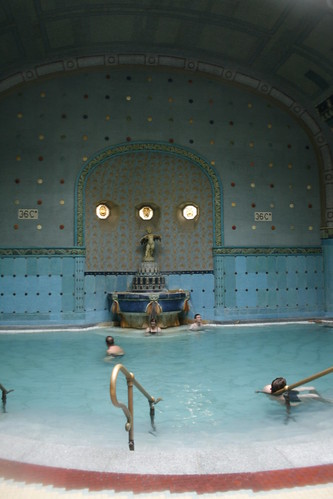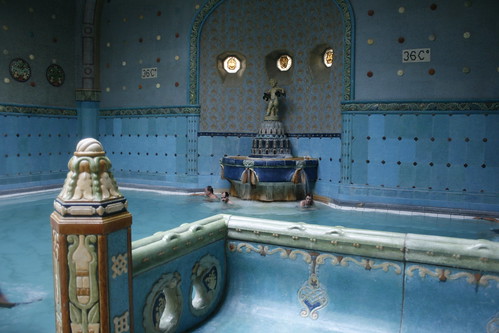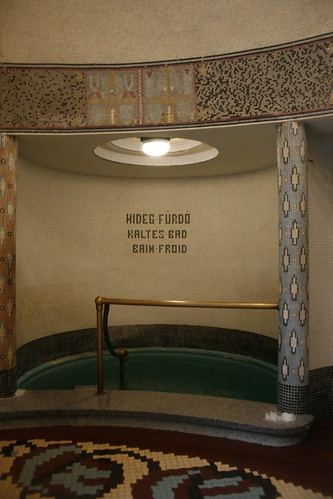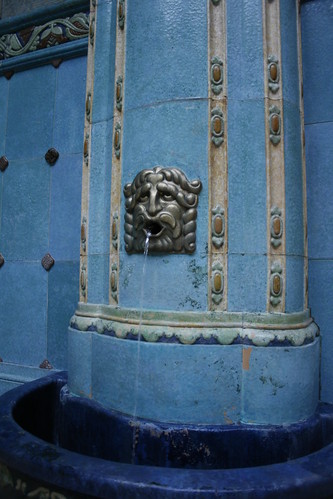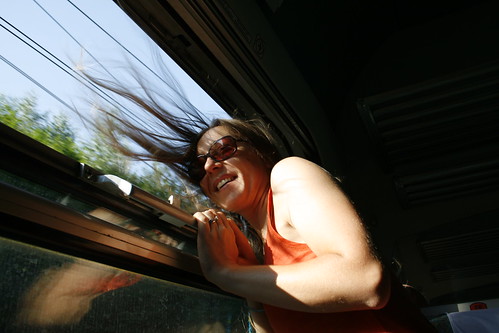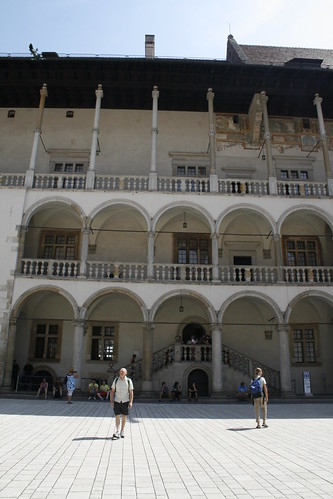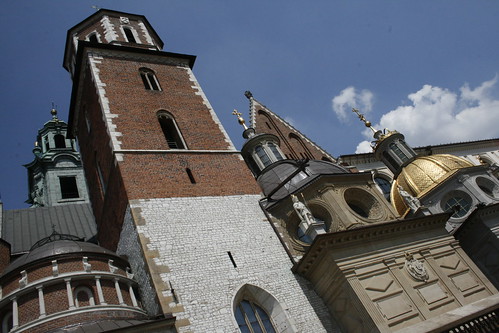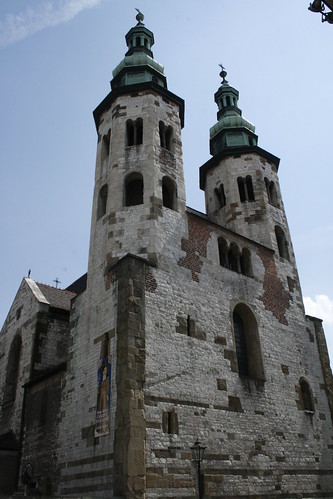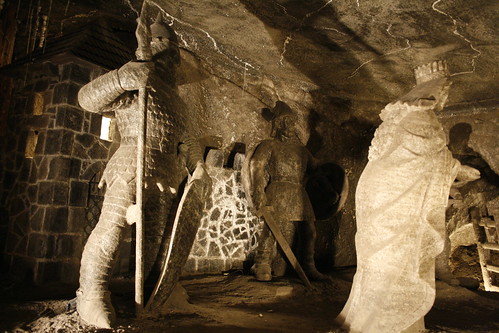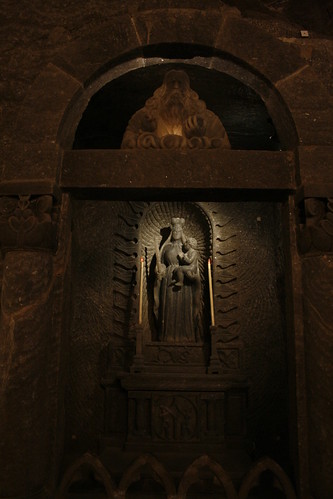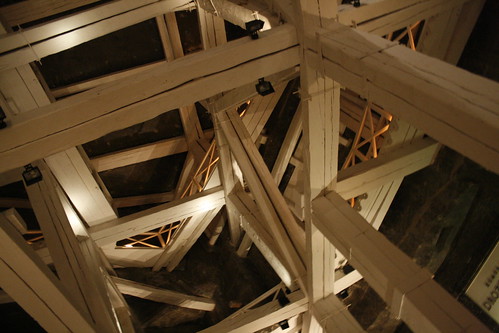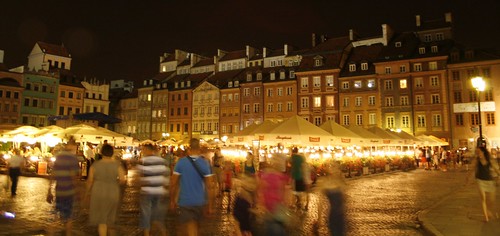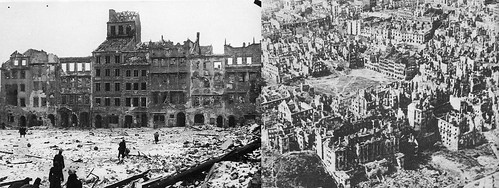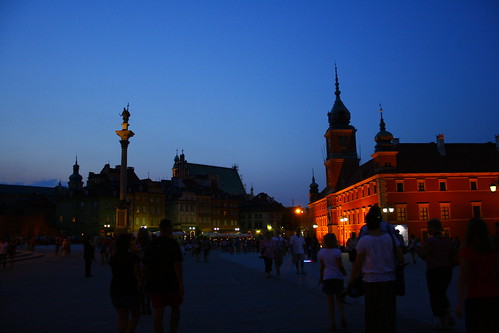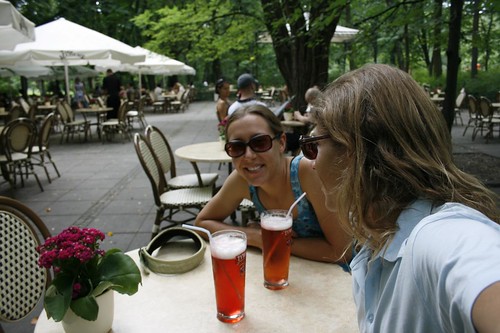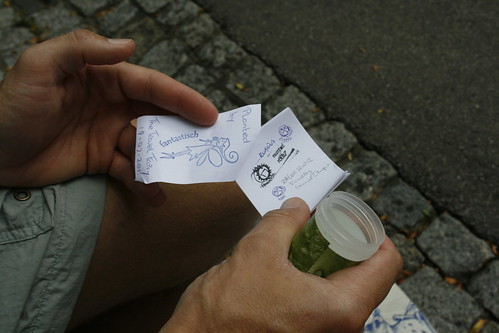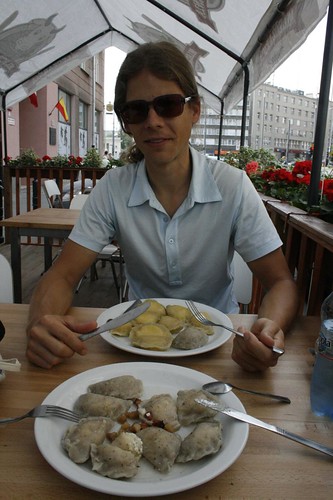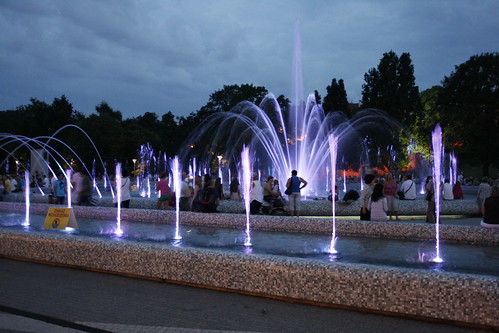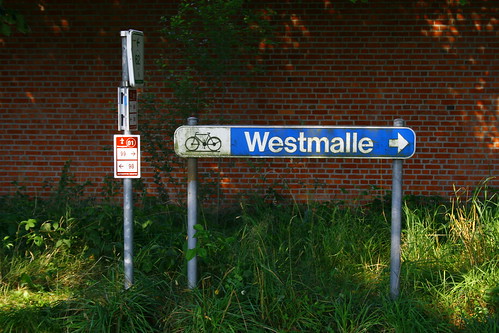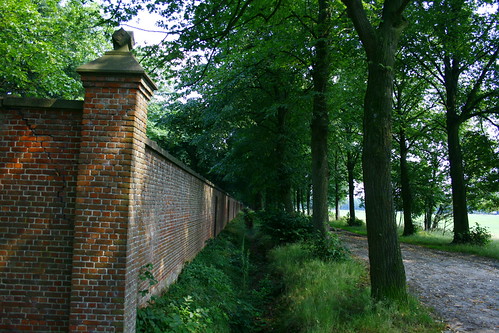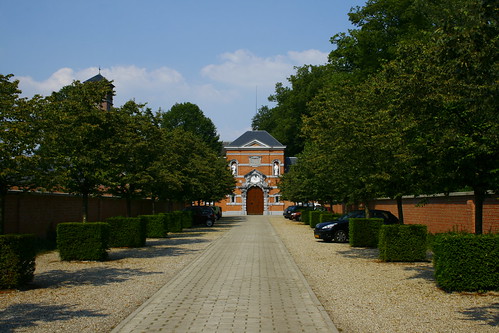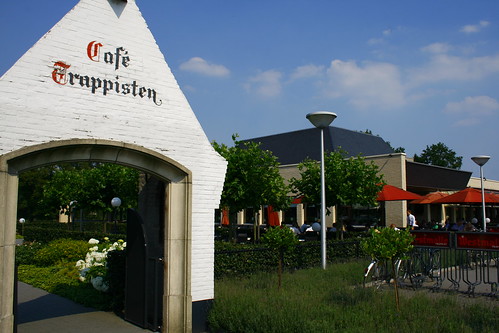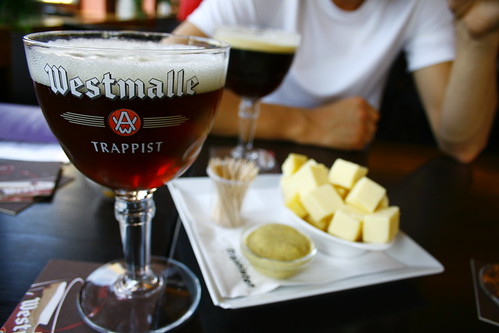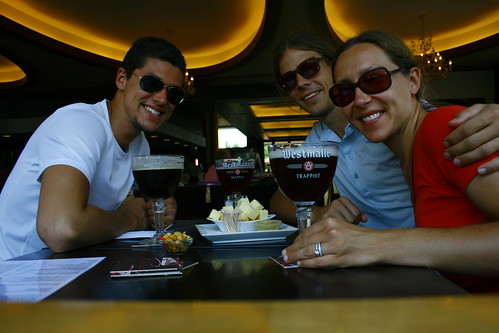Well, it wasn't long before we all decided that Germany was boring and we wanted to go check out a place we'd all never really seen before - The Netherlands! Mark and Romy were into seeing the coast (I was too but not as much), and I wanted to see the windmills and all the dikes. So we arranged a rental car, and soon we were on our way.
We busted out of Braunschweig, heading west towards the ocean. Kind of different, much of the coast at the Germany/Netherlands border along the ocean is extremely tidal. The coast is a huge mud flat for kilometers out to a set of barrier islands. You can literally walk to them if you're fast. Then, when the tide comes back, the coast looks like a coast again. Boats return, people start swimming, kites start flying, etc. At one point, we accidentally stopped at a nudist beach. At first Mark and Romy were very intrigued, but when we realized it was a bunch of old fat men, we decided to quickly head back to the car.

Nude mud guy at The Vat, Germany.
However, something off in the muddy distance caught our eye. We did not have a pair of binoculars, so we decided to take a picture with full zoom. When we realized what it was that we saw, we were just shocked. Apparently, a naked dude was running around far off shore in the mud, wiggling his butt into the sludge, pausing for a bit, and then running off to another place to do it all over again! GERMANS ARE JUST PLAIN WEIRD (at least this guy was)! I mean come on, it looks to me like there was a little boy out there too!!!
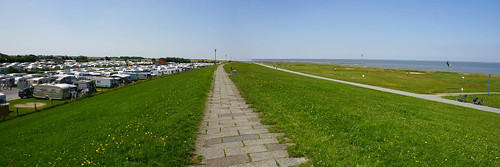
There are many campgrounds we saw on the map along the coast. This made us very excited because we wanted to camp and keep the trip as cheap as possible. Our mood slightly changed though, after we came to the first one (see picture above). Apparently, when Europeans "camp," its basically like going to an American trailer park. Richer families already have them permanently set up, with mini fences and everything! The one-night-only, tent campers are given a spot in a grassy field. And the spot wasn't even cheap! 35 euros per night to camp in the grass! Oh well, it still was the cheapest thing we could find, and they did have showers. The campground we stayed at was right on the coast, with a small dike separating you and the vast Atlantic ocean. This was something we would eventually see as being very common in the Netherlands. Dikes, dikes, and more dikes!
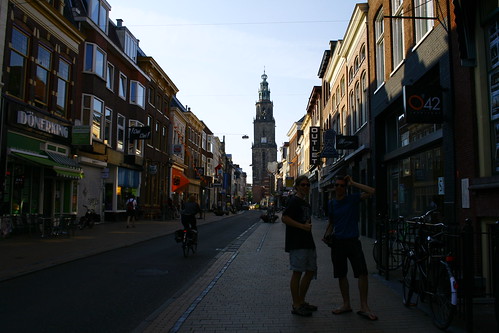
Wandering the street of Groningen, very confused.
Believe it or not, we got a little tired of driving over random dikes, staring at a mud flat which was supposed to be the ocean (the excitement of seeing the weird naked dude passed after a while). I make it sound horrible, but it really wasn't. I'm not too much of an ocean person I guess. Eventually, we couldn't keep following the tiny dike roads along the coast because of the crappy map we had, so the next day we turned inland towards one of the bigger cities to do some sight seeing. We stopped in Groningen, the Netherlands, for an afternoon of strolling the city streets.

Stopped for a few snacks before dinner time.
Groningen was full of surprises! We parked the car as close to the city center as we could, without having to pay, and then we just started walking. We strolled through the town square, looked at all the old buildings and churches, and almost got run over by the bicycle gangs that greatly out number the cars in the city. Mark had never been to a country where you could buy so many drugs legally, so it wasn't very long before we found a coffee shop. We bought ourselves a few space cakes, and continued on our adventure. There were so many parks, and we really liked the city a lot. It was getting close to sunset, so we started looking for hostels we could stay at. However, when we stopped in to ask how much they were charging, it was just crazy! Now, I realize I may make us sound extremely cheap, but we just came from Norway, where we were raped of all our money. So excuse us for trying to squeeze out a few more days of traveling on the cheap!
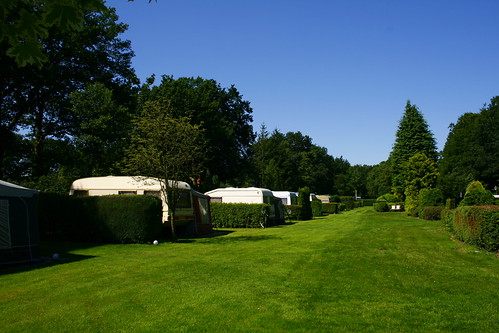
Another pristine, well manicured "campground" where we spent the night.
The nice people at the hostel recommended we camp instead, and pointed us to a camp ground just outside of the city border. We studied the map they had on the wall, but by this point, we were deep in our space cakes. They also had a nice interactive computer screen on the wall which showed a bunch of campgrounds out in the country side surrounding the city. We had plenty of options. So we headed back to the car, and tried to make our way to the nearest campground. We were so sure how to get there, until the streets started going one way only, or were blockaded for some reason or another. Soon we were driving in circles, trying to find detours. Finally we just decided to park and figure out how to get
out of the city. Groningen chewed us up and decided to spit us out. The general direction we wanted to continue in was south, so we picked the main road out south, and finally got out of there. After only a short while, we found a small campground.
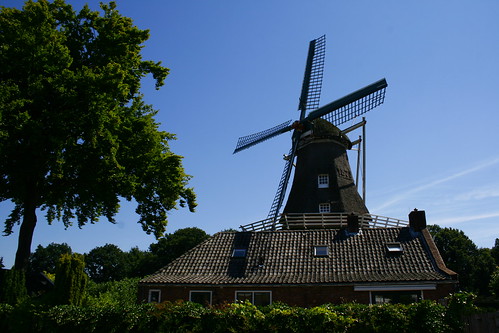
A nice windmill!
The campground had a locked gate in front of the entrance, so we parked the car to one side and Romy and Mark walked in to find the manager. I stayed in the car, waiting. Almost immediately after they left, a small old woman appeared out of nowhere and started circling the car. I was just staring at her, hoping she would go away. Then she started mumbling to herself. I was getting a bit freaked out. Then she called over to an old man, who also seemingly appeared out of nowhere, and joined her in pacing, circling around the car. Luckily, Romy, Mark, and the manager returned. The old man and lady started sqwaking to the manager, and then I realized it was because we had parked the car in front of her 'spot.' After we explained ourselves, the manager opened the gate and showed us to
our 'spot.' A little area between pristine manicured hedges and trimmed grass. We were very happy, and set up camp for the night.
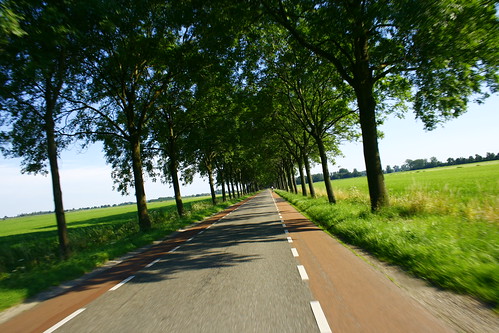
The Netherlands is a flat country, perfect for long peaceful bicycle rides.
The next morning, the bathroom cleaning lady (who was extremely grumpy) did not let us enter the bathroom because it was clearly cleaning time. This campground was as rigorous with their scheduling as the lawns were neat. I have a feeling it was a senior campground and they just let us stay the night. We ate breakfast while we were waiting for the cleaning lady to finish, although I didn't notice any difference from before she cleaned to after she was done! We decided to keep heading south, making random stops at anything we found interesting along the way. We decided to turn the trip into a culinary one, focusing on Belgian-style brewed beers (of which every town had their own brew). It was so much fun trying all the different beers, which you probably can't buy very far outside of the city.
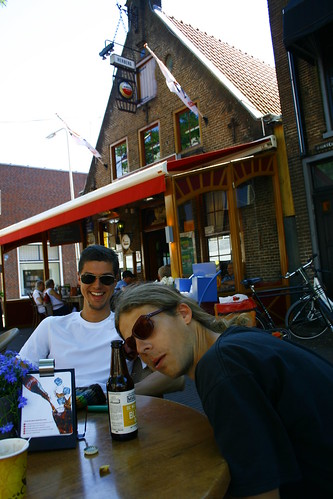
Having a beer in Meppel.
One of the places that Mark saw on the map as we were driving was the town of Gouda! As in, gouda cheese! This was the town that the cheese was made in, with the local milk and recipe. So we just had to stop. What I found interesting was that once we got into the city, and started wandering around, it looked a lot like Belgium (I guess we were getting kind of close to the border). Also, there wasn't any big touristy cheese vibe that I could notice, which was nice, although we saw huge cheese wheels decorating the streets everywhere. We were surprised when we saw the large town square with a tall strange looking tower building in the middle. After wandering for a bit, we stopped at a cafe to order some beer and try the cheese.

The town square in Gouda.
The menu didn't have a cheese platter, so we asked the waitress if she could make one for us with a few local cheeses. She was excited to do it, and came back explaining what they all were. It was all soooo yummy! Throughout the trip, a major theme was "grazing." We never ate full meals the entire time. We only did grazing. Basically, its a thing "best done in herds," as Mark later described it. What you do is buy a whole bunch of fresh fruit, veges, and snacks like nuts, cheese, etc. Then you munch on them all day, whenever you get hungry. The cheese tasting platter was a part of this new grazing diet we made up. Its amazing how much food you can try without getting fat or overly full, if you only do a few bites here and there.

Having some beer and sampling the cheese in Gouda!
That night we camped at a private campground again, located next to a nature preserve back on the coast. There were dunes and tall prairie-like grasses everywhere! We arrived rather late, just after sunset, and there was a gate that kept the campground locked up and secure. At this point, we just started learning to accept the European style of camping. We had to call the campground attendant, who arrived about 10 minutes later after peddling her bike from some other location (I wonder why the host didn't live at the campground?). Anyway, she was very nice, and got us a camp site next to some monster tents and permanently set up canvas houses. She was very concerned about informing us which tents had children in them, and which tents had surfing beach bums, and which were empty and for how long. We kept telling her we didn't care, that we just wanted to stay for one night, but she just had to tell us the whole life story of each summer resident we might pitch our tents next to. When we finally got around to paying for a spot and thanking her (almost an hour later), she disappeared, off on her bicycle again.
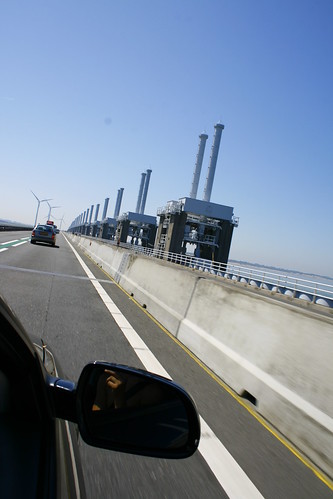
This is how the Netherlands holds back the Atlantic Ocean. With an enormous dam!
The next morning we drove along the coast, heading south. Except this time, the beach roads were very large, and they took us over the top of extremely large dams that were literally holding back the Atlantic Ocean! The Netherlands, which when translated means "the low lands," used to be very marshy. Over time, people began building dikes and levees to farm some of the land. Today, they are at the point where the levees and dikes are now insane dams with complicated gates, allowing a controlled amount of the ocean water in. Dotted in between the huge dams were nice beaches (not the muddy wasteland of the Vat in Germany) and sections where the original dunes were preserved.
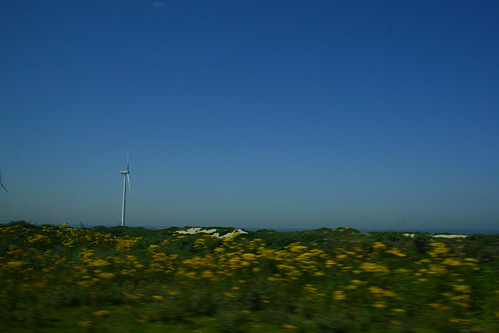
This part of the Netherlands coastline was preserved (except for the wind turbine).
At this point, we were almost at the border of Belgium, and since we already started the beer tasting ball rolling, we figured we would try and visit some of the trappist monasteries in Belgium that are famous for brewing high alcohol, sweet and tart, complex tasting beers. We decided to head towards the town of Westmalle next. . .
